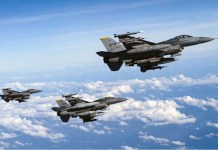A photographer recently captured some images of a Lockheed Skunk Works X-59 QueSST (Quiet SuperSonic Technology) testbed aircraft on its way to the Lockheed Skunk Works’ Fort Worth, Texas factory.
The silhouette of the supersonic jet is enveloped in blue plastic and attached tail first aboard a large trailer bed in Marana, Arizona, according to images taken by Aldo Boccaccio and published by The Drive.
Skunk Works' X-59 quiet supersonic testbed jet spotted on a trailer heading to Texas:https://t.co/iZdnLYguqg
— Tyler Rogoway (@Aviation_Intel) December 23, 2021
The X-59 QueSST is an experimental aircraft that is being developed by Lockheed Martin for the American space agency NASA. Lockheed Martin was awarded the contract to develop a quiet supersonic plane in 2016, since then the project has made significant development.
Skunk Work’s facility at the United States Air Force’s Plant 42 in Palmdale, California, has been working on the plane since 2018.
The current plan is to transport the X-59 to Lockheed Martin’s Texas plant, which is famed for housing the F-35 Joint Strike Fighter production line, for structural testing before returning it to Palmdale for the initial round of flight testing.

As EurAsian Times previously reported, the disruptive noise and trembling produced by planes flying faster than the speed of sound are still major roadblocks to commercial supersonic aircraft. Although the sonic boom is only experienced briefly, it is really produced indefinitely as long as the aircraft is flying at supersonic speeds.
Depending on when the supersonic plane passes through the region, various people will hear the thunderous impact at different times and at different points along the flight path. As a result, the United States and a number of other countries have put a ban on such flights in their air space.
The X-59 and the QueSST program’s objective is to examine the technology that could greatly decrease the sound and felt impact of sonic booms on planes traveling faster than the speed of sound, as the name implies.
X-59 QueSST Design
The X-59 is an innovative design that makes extensive use of components from other Lockheed Martin aircraft in order to keep the design as basic and low-cost as possible.
“Landing gear from an Air Force F-16 fighter, a cockpit canopy from a NASA T-38 trainer, a propulsion system part from a U-2 spy plane and a control stick from an F-117 stealth fighter is among the repurposed parts to be used on NASA’s newest airplane,” according to NASA.

The X-59’s structure, according to Lockheed Martin, would considerably reduce the decibel level of a sonic boom reaching the ground. The plane will take to the skies as part of a mission to gather data on silent supersonic flight and evaluate public reaction to supersonic “thumps.”
The success of this concept could pave the way for commercial supersonic flights, which would substantially reduce the amount of time it takes to travel long distances.
The firm’s demonstrator model is a single-engine plane with a length of 28.7 meters and a wingspan of 9 meters. The plane has an extended nose that reduces noise levels. The X-59 is driven by F414-GE-100 turbofan engines that were specifically designed to be used on the plane.
By 2025, the plane is projected to meet International Civil Aviation Organisation (ICAO) requirements. The pandemic, however, has caused delays in the project, The EuraAsian Times had earlier reported.
Representatives from Skunk Works claimed earlier this year that just about 10% of the design is completely new. At the same time, the company further stated that this plane was used to test new sophisticated manufacturing techniques, such as the large, single-piece composite skins on the wings.

One of the more remarkable aspects of the design is the pilot’s total absence of forward sight. Rather, the X-59’s pilot will employ a remote vision system known as the eXternal Vision System (XVS) to “see” through feeds from an array of forward-facing high-resolution cameras.
This design enables the aircraft’s complete front end to be more tuned for sonic-boom-mitigating supersonic flying.
Development Timeline
In February 2016, NASA awarded Skunk Works, a Lockheed Martin division, a $247.5 million contract for a preliminary design of the X-59. The goal was to have the plane pre-designed by 2020 and delivered by 2021.
The outbreak of the COVID-19 pandemic, however, had caused the flight testing to be delayed.
Skunk Works was chosen in April 2018 to develop, build, and test the X-59, and in November of that year, the first parts for the X-59 began to be manufactured. The study findings and concept for the quiet supersonic passenger airliner were presented in June 2019. NASA and Skunk Works concluded the critical design evaluation for the X-59 in September of that year.
Additionally, the airplane was lifted away from the jig support system in late October of this year. This technology, which works similarly to scaffolding, ensures that all of the aircraft’s hardware is correctly installed during the production process.
According to NASA’s official timeline, the X-59 will make its first flight by next year. Initial flight testing is projected to last nine months and stretch into 2023. The initial flight testing will demonstrate things like the basic airworthiness of the aircraft.
During the Community Response Study phase, which will occur between 2024 and 2026 and include flights over numerous American cities, the public will be asked for feedback. People on the ground will be notified of X-59 flights via push notifications, and reactions will be collected.
- Contact the author at ashishmichel@gmail.com
- Follow EurAsian Times on Google News




